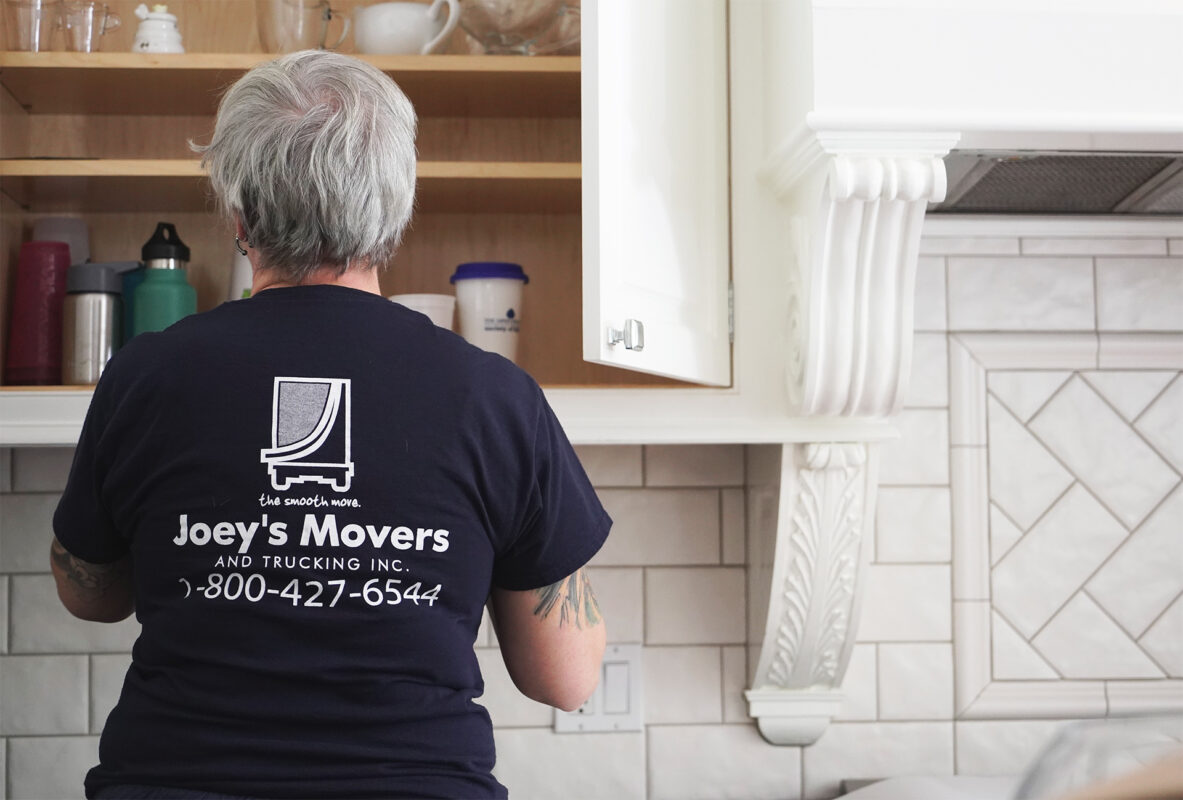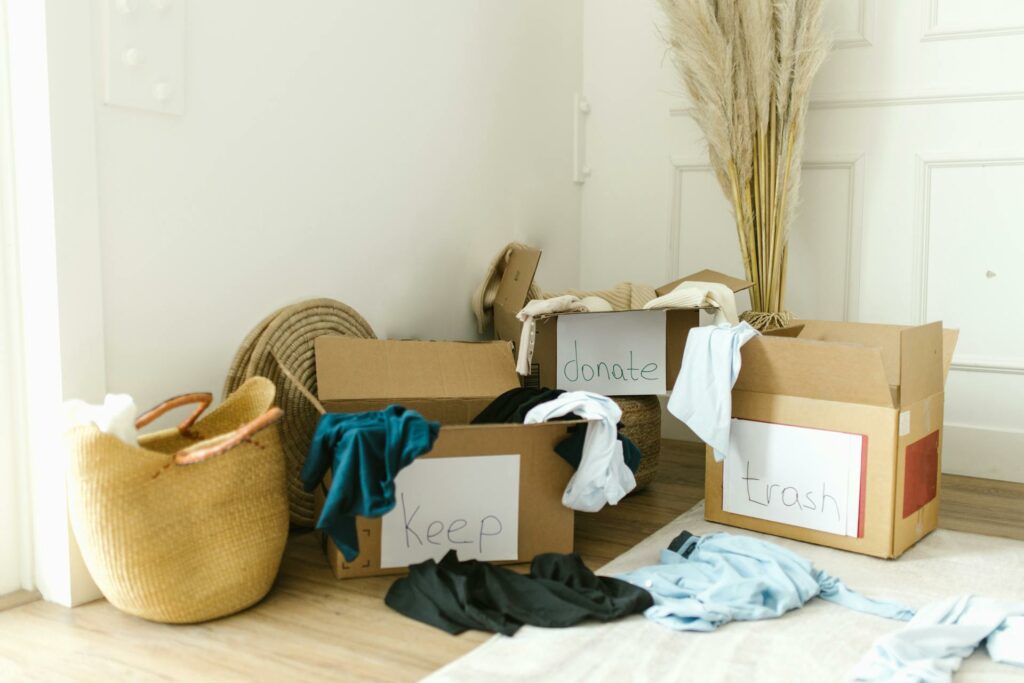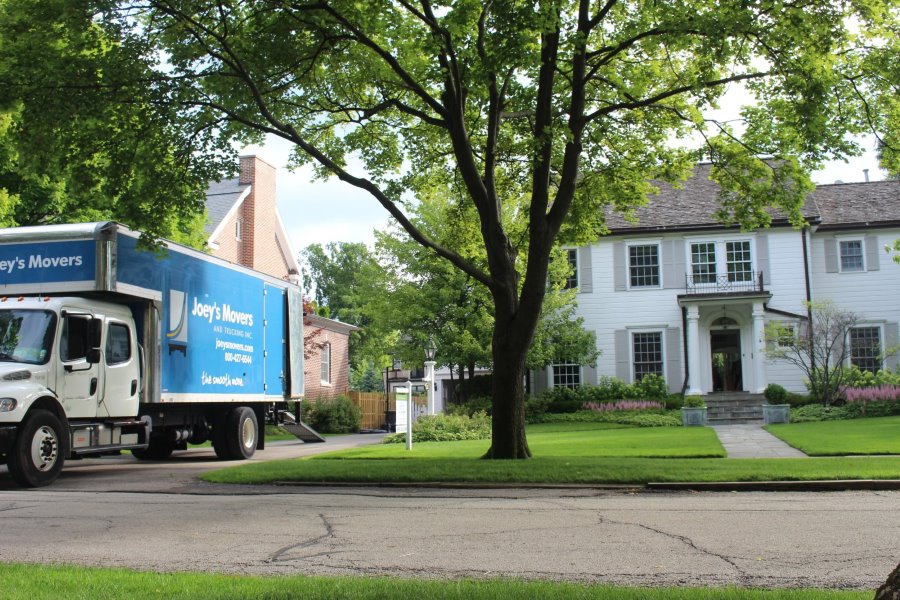Feeling overwhelmed by clutter is normal. If you’ve ever thought, “My house is so cluttered I don’t know where to start,” you’re not alone. Our experts are eager to share real tips and tricks we’ve picked up over the years to handle it!
In this guide, we’ll discuss real tactics professional packers and movers use to declutter areas when the process feels overwhelming. If you’re unsure how to start decluttering when overwhelmed, these tips will help you reduce stress and speed up the organizing process. If you are planning to move, they will also help you reduce moving costs.
Ever thought about hiring movers to help declutter your home? Yes—movers help with that too. Learn how they make it easier. Give us a call at (847) 674-7779, or get an online quote.
Why Decluttering Feels Overwhelming and How to Overcome It
Have you ever wondered why decluttering feels so overwhelming at home or in your workspace? Clutter is more than just a measure of how many things occupy a space. When decluttering feels overwhelming, it is often due to some combination of psychological factors like stress, indecision, or emotional attachment.
Emotional Attachment
Many of our belongings hold meaning. That chipped coffee mug with the broken handle from your first apartment. The half-working lamp and vintage knickknacks you inherited from your grandparents. Letting go can feel like disrespecting a memory.
Movers and professional organizers can be useful in this case because they do not have a personal attachment to any of your things. At the same time, they can be objective and help clients sort through their clutter with empathy, not judgment. We’ll go over tips for “letting go” on your own further into this guide.
Decision Fatigue
Clutter isn’t just “stuff.” It’s hundreds of tiny, unresolved decisions. When those pile up alongside your daily work, family obligations, and the stress of cleaning or moving, it’s no wonder trying to declutter at work or home becomes overwhelming.
Movers simplify the organizing process by reducing the number of choices you have to make per session. We’ll discuss some key strategies to reduce the choices you need to make later in this guide.
Fear of Loss
“I might need it one day.”
“I want to pass it on to my kids when they move out.”
“I don’t need it now, but I’ll need it if…”
The future is a powerful and compelling force, especially since we have lived with so much change and uncertainty in the last two decades. From housing crises to year-long quarantines, we never know what the future will hold. We want to have what we need on hand, and we often want to pass on helpful and sentimental things to future generations.
If you find yourself struggling to let go of items “just in case,” consider hiring a professional mover or organizer to help you. They will not be invested in the “what ifs” and future dreams you have for different items, so they can offer objective and empathetic feedback and push the process forward.
How to Start Decluttering When You’re Overwhelmed
The key to any good battle plan is a good strategy. If you’re unsure how to start decluttering when overwhelmed at work or at home, here are some simple, proven steps.
The “One Small Win” Strategy
When we look at the whole task at once, it is easy to be overwhelmed by choice paralysis. One of the most effective ways to get started is to forget the whole and work in smaller, manageable portions. Meeting smaller goals helps build momentum and a sense of progress, and focusing on that one small area also helps reduce decision fatigue in the process.
For example:
- Collect old magazines or newspapers for recycling
- Toss expired products from the pantry or the fridge.
- Clear a surface you use often, like the counters, a desk, a coffee table, or a nightstand.
- Organize a single drawer or cabinet.
Start with something small that can be completed in a few minutes, like a drawer, a windowsill, or your nightstand. Set a timer for fifteen minutes, and clean that space. Don’t worry about the rest yet (unless you feel like it after you are done!)
The 20/20 Rule of Decluttering
Professional organizers use the 20/20 rule of decluttering to help clients overcome lighter emotional attachments and the fear of loss. If you find yourself conflicted over discarding something because you might need it or want to pass it down later, ask yourself, “If I lost this today, could I replace it for $20 or in under 20 minutes?”
If the answer is yes, toss it out. This will save you time and energy and significantly reduce moving costs. Plus, you will not need to find a place for all the outdated cables, unused kitchen gadgets, surplus party favors, unread magazines, and unworn clothes that you accumulated.
The Four-Box Sorting Method
Professional movers and organizers find the four-box method incredibly useful for classifying clutter. In this strategy, every item is categorized in one of four “boxes.” These boxes can be physical storage containers or a designated space. Every item in the house should fall into one of four boxes labeled:
- Keep
- Donate
- Sell
- Discard
This helps to deal with all three major hurdles. You physically see how many items you are holding onto. Ideally, you are using the 20/20 rule as you decide how much goes in the Keep pile. You reduce decision fatigue to four choices. Then, the fate of each pile is dictated by this choice.
Low-sentiment areas like utility closets or bathroom sinks are great places to start because they hold the fewest items with emotional attachments. Try to touch each item only once in the sorting process. Don’t second-guess your choiceunlessit is to move something from the Keep pile to one of the other three.
Declutter Based on Your Main Goal
In goal setting and motivation, this is also referred to as “Know Your Why.” Having one clear goal helps you focus and prioritize your efforts to meet that goal.
For example, if you are planning to move, your goals and priorities will differ greatly from when you are doing some spring cleaning or adding a new desk to someone’s room.
If you are moving or relocating, your main goals will involve removing absolutely everything from a space and moving items to either storage or your new home. Tasks and priorities are things like:
- Prioritize letting go of bulky and duplicate items first, such as extra furniture or mismatched dish sets. Downsizing large items clears space to work and significantly reduces storage and moving costs.
- Let go of anything that won’t reasonably work or fit in your new or temporary living space.
- Reduce the amount of stuff you need to pack and unpack and the amount of storage and transportation you will need. Clearing out “just in case” items is a strong priority.
If you are organizing and maintaining a space, your main goal is to make the space suitable for whatever you plan to do there. Tasks and priorities may look like this:
- Focus on optimizing the main room centered around your goal. If you are renovating a bathroom, focus on clearing the bathroom and any spaces the experts need access to. If you are cleaning up for guests, start with where the guests will spend the majority of their time.
- The room should only store things you need for the room. A kitchen, for example, should have an area for preparing food that is kept clear at all times. It should not have toys, living room remotes, garage power tools, and bedroom socks scattered around.
- Determine if an item’s location makes your lifeeasierorharder. You should strive to make the space as convenient for your needs as possible.
Focusing your energy around a goal will help you overcome a lot of the mental blocks that lead to feeling overwhelmed.
A Room-by-Room Decluttering Plan
Decluttering becomes much easier when rooms and areas are separated into manageable, bite-sized chunks. Here are some expert tips from our movers on how to tackle each room.
Living Rooms, Lobbies, and Common Spaces
Visual noise is your biggest enemy here because they are your hotspots where guests get their first impression of your space. Get rid of things like:
- Stacks of outdated magazines or newspapers
- Loose cords and broken knick-knacks
- Outdated, poorly aged, or unappealing decor
Anything that doesn’t serve a purpose or help make the room more visually appealing can go!
You might want to look for hidden clutter, such as remote controls, empty device boxes, dusty decorative objects, or the dreaded ‘just in case’ shelves or drawers. If something belongs to another room, return it immediately or put it in a dedicated bin to do so after you finish cleaning. Anything that doesn’t have a dedicated use in space can go!
Kitchens
The kitchen is one of the most important areas in your daily life. It’s where you prepare your meals, socialize, and sometimes eat. The counters often double as work space, especially if space is limited in your home or office. However, this room also collects clutter like a magnet.
When cleaning your kitchen:
- Donate or discard duplicate utensils and cookware, novelty items, and small appliances. If in doubt, lean on the 20/20 rule.
- Donate or discard any old cookbooks and cooking magazines that you have not opened in a year.
- Clean out any expired foods, including any almost-expired foods that will not be eaten in the immediate future. If you are moving, make meal plans to use up any remaining perishable food before the move date.
- Toss everything related to takeout, including menus and old hot sauce packets.
- Remove the contents of all clutter catcher drawers and repurpose them for specific kitchen storage.
- Focus on specific spaces first, like the pantry, under the sink, and specific cabinets.
- Toss any ragged and stained towels and potholders. Color coordinate their replacements to create a more cohesive look.
If you are moving, our pros recommend that you create and label a priority unpacking box for daily kitchen essentials. The last thing you want is to finish a move and realize that you have to sort through a pile of boxes to find the basic necessities to cook dinner that night. Keep this box easily accessible before and during the big move so you can have it handy right away.
Bedrooms and Closets
We have a tendency to put things out of sight and out of mind. Closets become the largest clutter catchers as places to put unwanted gifts, boxes to unpack later, clutter to get out of guests’ sight, and clothing we buy and never wear.
If you haven’t worn something in over a year, you’re probably never going to wear it. Donate it or discard it to save space and make finding your other clothing easier. Pro organizers also recommend turning your hangars the ‘wrong way’ once a year. As you wear your clothing throughout the year, return them with the hangar in the ‘right’ position. This helps you see which clothes were never worn, and you can dedicate yourself to getting rid of them.
- Try to use wardrobe boxes for easier packing.
- Get rid of bulky furniture and decor that you do not use to make the room more open and inviting.
- Vacuum seal seasonal blankets and off-season clothing to save space and protect them from moths and dust.
- Make sure to label your boxes and bins for fast unpacking!
- Clear off bedside tables and floors.
- Remove any clutter or moving boxes that you put in the room to “deal with later.” Put the contents where they belong or discard them.
- Color-coordinate sheets, pillows, and curtains to create a more cohesive look.
Offices & Workspaces
A tidy workspace improves focus and creates a good impression.
While physical clutter can be important, digital clutter can contribute to feeling overwhelmed at work. The chaos of random desktop icons and poorly labeled folders makes it challenging to find what you need to access. Email lists and subscriptions you long forgot you signed up for flood your inbox and bury important communications. Downloads take up storage space with outdated programs—some of them potentially clashing with your system in odd ways!
- Try to unsubscribe from any email lists you haven’t actively read in a month
- Clear your desktop, organize, and relabel folders based on how you search for them
- Delete non-essential downloads older than thirty days, and keep current programs updated
- Label cords and accessories, and use ties to keep them from getting tangled into a messy-looking nest
- Store supplies in closed labeled containers in a dedicated area.
- If anything in your space belongs somewhere else, return it before clocking out for the day.
- At the end of your workweek, completely clear and wipe down your desk or workstation so you can return to a fresh and clean space.
What to Do With Decluttered Items
You’re almost done! You’ve sorted and allocated everything. But what is next?
Storage
If you are relocating to temporary housing or have more stuff than you have space for, you may need to put less-used items into storage. Just don’t use it as a way to avoid decluttering unnecessary items from your life entirely! Reevaluate stuff you put into storage every six months and decide if you still believe it is worth keeping. Label items clearly and set a date where, if you haven’t used it, you pledge to sell or donate it. If it is already out of sight and out of mind, it might as well be out of your life entirely.
Donation
Local charities are always in search of good-condition clothes, books, toys, home goods, and appliances. You can donate almost anything you can think of to Goodwill, Salvation Army Family Stores, or Habitat for Humanity. Local shelters, schools, or churches in your area may also have use for specific items! For example, a school may appreciate school uniforms and gently used backpacks the kids have outgrown to give to needy families. Listing bulky items on the “Free” section of a local online marketplace like Facebook or Nextdoor can also be a fast way to find someone who can use them.
Some moving companies offer haul-away services! Check with us to see if we can remove your clutter as part of our pre-move decluttering services.
Sell
For higher-value or like-new items, you can sell some of your unused items to recoup part of your investment. Facebook Marketplace, OfferUp, and Craigslist have large user bases and make listing simple. Some stores, like Staples and Best Buy, will allow you to trade in certain electronics and other items for store credit if you’re remaining in the area.
Try to keep a reasonable time limit on items. If they don’t sell, donate them instead. There’s no point in holding onto clutter that doesn’t have a local or online selling demand.
Trash and Recycle
Some things just need to go, such as broken appliances, damaged furniture, and expired products. Be honest with yourself on whether you can or will ever actually fix or use anything that isn’t functional anymore. Is it truly worth keeping?
Recycle your electronics, batteries, and paints responsibly. Most cities offer quarterly hazardous waste pickups. Take advantage of these and do not throw dangerous trash away with the rest.
Long-Term Habits
Decluttering once is great, but keeping it that way is the real trick. Here are some expert tips to help you control clutter in your space for the long term.
The “One In, One Out” Rule
To prevent a fresh accumulation of clutter, consider utilizing the “One in, one out” rule. Whenever you buy something new, you should try to get rid of something. If you buy a new pair of shoes, discard or donate the shoes they replace. If you get a new tablet, make sure the old tablet and its cords find a new home. If you get a new knick knack, donate a piece of decor.
This helps you do two things: It keeps unused items from piling up and makes you stop to think about what you will need to give up to bring the new item in. This can help control impulse purchases and reduce hoarding discounted bargains for “one day.”
Monthly & Seasonal Purges
Make sure to declutter regularly! If it helps, you can help keep track by doing them around big events or seasonal changes. Spring break is a good seven days to do a room-by-room purge, and daylight savings might be a good time to clear out your fridge.
Here is a recommended breakdown of how often to do which decluttering tasks:
Monthly: paper clutter, loose cords, fridges, and junk drawers. Return any items to the rooms they belong.
Quarterly: Clear closets of clutter boxes and “out of sight, out of mind” items. Sort tool boxes and organize digital clutter
Twice a Year: Room-by-Room Purge, Storage Areas
Annually: Clean garages, attics, and basements. Donate electronics, clothing, and small appliances you haven’t used in a year. Replace any ragged towels and worn-out sheets. Keep the replacements color-coordinated for the room.
Make sure to note the dates on your calendar to keep the habit alive!
Embrace Minimalism
Minimalism naturally helps reduce clutter in your home by encouraging you to keep only what you need. This creates more open and welcoming living spaces, and you will enjoy more focus from the reduced distractions around your space. As a bonus, when you need to move, it significantly reduces moving costs.
- It reduces the time it takes packers and movers to relocate your belongings
- You can rent smaller moving vehicles and storage units, if applicable
- It reduces how long it takes to unpack
- It makes finding essential items easier
FAQ
How do I start decluttering when I’m overwhelmed?
Pick a small area or one very specific small task you can complete in just 10 or 15 minutes. With systems like the four-box method, you can reduce the active decisions you have to make.
Why is it emotionally hard to let go of objects?
Items help us remember people and events to which we have a strong attachment. You can honor a memory without an object, though. That memory lives in you. If you’re having trouble letting go of clutter due to an emotional attachment, try taking a photo of the item before you part with it. You could also create a memory box that can fit the most important heirlooms and sentimental items. Make sure to keep to the space allocated in this memory box..
How do movers help with decluttering?
Movers use proven systems to sort, label, and haul to make moving faster and more efficient. They don’t have an emotional attachment to your stuff, so they can offer empathetic advice on what to discard. They know exactly what people need to take and what to leave.
Final Recommendations
It can be hard to start decluttering when you are overwhelmed. It’s emotional. It’s hard to let go of things you might need in the future. Just the thought of the sheer number of choices to make can be exhausting. But if you commit to starting small and using strategies like the 20/20 rule to determine what you need to keep, you will find it a lot easier to do once you get started.
Whether you’re moving, downsizing, or just tired of living with the weight of “too much,” we hope these strategies will help you breathe a little easier and move forward with purpose.
Do you need help decluttering before a move? We specialize in organized downsizing and clutter-smart packaging. Call us today at (847) 674-7779, or get a free online quote.
Photo by RDNE Stock




